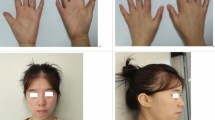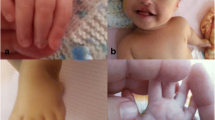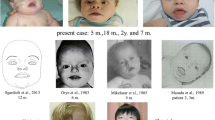Summary
An aberrant X chromosome containing extra material in the long arm was observed in a psychomotoric retarded boy and his healthy, short-statured mother. The proband showed generalized muscular hypotony, growth retardation, and somatic anomalies including hypoplastic genitalia and cryptorchism.
Chromosomal banding techniques suggested a tandem duplication of the segment Xq13→Xq22.
In the mother the vast majority of lymphocytes showed late replication of the aberrant X chromosome. Some of her cells, however, contained an apparently active aberrant X. Both the early- and late-replicating aberrant X exhibited late replication patterns very similar to those described for normal X chromosomes in lymphocytes. Asynchrony of DNA replication among the two segments Xq13→Xq22 in the dup(X) was never observed.
We consider that the clinical picture of the proband is caused by an excess of active X material.
Similar content being viewed by others
References
Buckton, K. E., Jacobs, P. A., Rae, L. A., Newton, M. S., Sanger, R.: An inherited X-autosome translocation in man. Ann. Hum. Genet. 35, 171–178 (1971)
Bühler, E.: Clinical and cytological aspects of sex chromosome activity. Hereditas. 86, 63–74 (1977)
Bühler, E. M., Jurik, L. P., Voyame, M., Bühler, U. K.: Presumptive evidence of two active X chromosomes in somatic cells of a human female. Nature 265, 142–144 (1977)
Cattanach, B. M.: Position effect variegation in the mouse. Genet. Res. Camb. 23, 291–306 (1974)
Crandall, B. F., Carrel, R. F., Howard, J., Schroeder, W. A., Müller, H.: Trisomy 13 with 13-X translocation. Am. J. Hum. Genet. 26, 385–392 (1974)
Daly, R. F., Pätau, K., Therman, E., Sarto, G. E.: Structure and Barr body formation of an Xp+ chromosome with two inactivation centers. Am. J. Hum. Genet. 29, 83–92 (1977)
De la Chapelle, A., Grönman, P., Latt, S. A.: Multiple cytogenetic methods used to identify a new structural rearrangement of the human X chromosome. Cytogenet. Cell Genet. 20, 204–212 (1978)
Dewald, G., Spurbeck, J. L., Gordon, H.: Replication patterns of three isodicentric X chromosomes and an X isochromosome in human lymphocytes. Am. J. Med. Genet. 1, 445–460 (1978)
Distèche, C., Hagemeijer, A., Frederic, J., Progneaux, D.: An abnormal large human chromosome identified as an end-to-end fusion of two X's by combined results of the new banding techniques and microdensitometry. Clin. Genet. 3, 388–395 (1972)
Engel, W., Vogel, W., Reinwein, H.: Autoradiographische Untersuchungen einer X-Autosomentranslokation beim Menschen: 45,X,15-,tan(15qXq+)+. Cytogenetics 10, 87–98 (1971)
Gaál, M., László, J.: X inactivation pattern in an unbalanced X-autosome translocation with gonadal dysgenesis. Hum. Hered. 27, 396–402 (1977)
Grzeschik, K.-H., Kim, My. A., Johannsmann, R.: Late replicating bands of human chromosomes demonstrated by fluorochrome and Giemsa staining. Humangenetik 29, 41–59 (1975)
Hagemeijer, A., Hoovers, J., Smit, E. M. E., Bootsma, D.: Replication pattern of the X chromosomes in three X/autosomal translocations. Cytogenet. Cell Genet. 18, 333–348 (1977)
Jenkins, M. B., Davis, E., Thelen, T. H., Boyd, L.: A familial X-22 translocation with an extra X chromosome. Am. J. Hum. Genet. 26, 736–745 (1974)
Kim, H. J., Hsu, L. Y. F., Hirschhorn, K.: Familial X/X translocation: t(X;X)(p22;q13). Cytogenet. Cell Genet.13, 454–464 (1974)
Latt, S. A.: Microfluorometric analysis of DNA replication in human X chromosomes. Exp. Cell Res. 86, 412–415 (1974)
Latt, S. A., Willard, H. F., Gerald, P. S.: BrdU-33258 Hoechst analysis of DNA replication in human lymphocytes with supernumerary or structurally abnormal X chromosomes. Chromosoma (Berl.) 57, 135–153 (1976)
Laurent, C., Biemont, M.-Cl., Dutrillaux, B.: Sur quatre nouveaux cas de translocation du chromosome X chez l'homme. Humangenetik 26, 35–46 (1975)
Leisti, J. T., Baback, M. M., Rimoin, D. L.: Human X-autosome translocations: Differential inactivation of the X chromosome in a kindred with an X-9 translocation. Am. J. Hum. Genet. 27, 441–453 (1975)
Loeffler, L.: Papillarleisten- und Hautfurchensystem: In: Humangenetik, ein kurzes Handbuch, Band I/2. P. E. Becker (ed.) pp. 205–408. Stuttgart: Thieme 1969
Mattei, M. G., Mattei, J. F., Ayme, S., Malpuech, G., Giraud, F.: A dynamic study in two new cases of X chromosome translocations. Hum. Genet. 41, 251–257 (1978)
Opitz, J., Pallister, P. D., Ruddle, F. H.: An (X;14) translocation, unbalanced, 47 chromosomes. Cytogenet. Cell Genet. 12, 291–292 (1973)
Perry, P., Wolff, S.: New Giemsa method for the differential staining of sister chromatids. Nature 251, 156–158 (1974)
Schwanitz, G., Tietze, H. U., Pfeiffer, R. A., Grosse, K. P., Becker, H., Egger, H.: Duplication deficiency of an X-chromosome with and without 45,X mosaicism in three girls. Acta Genet. Med. Gemellol. 26, 277–281 (1977)
Sillesen, I., Rasmussen, K., Osterballe, O., Nielsen, J.: Center for Barr body condensation. A case of Turner's syndrome with 45,X/46,X,dic(X)(Xqter→p22::p22→qter). Hum. Genet. 33, 337–340 (1976)
Sinha, A. K., Pathak, S., Nora, J. J.: Fusion of two apparently intact human X chromosomes. Hum. Genet. 32, 295–300 (1976)
Sparkes, R. S., Salter, W. J., Blaker, R. G., Muller, H. M.: Insertional translocation into the X chromosome of a 46,XY male. Clin. Genet. 12, 114–118 (1977)
Sumner, A. T.: A simple technique for demonstrating centromeric heterochromatin. Exp. Cell Res. 75, 304–306 (1972)
Sumner, A. T., Evans, H. J., Buckland, R. A.: New technique for distinguishing between human chromosomes. Nature 232, 31–32 (1971)
Therman, E., Pätau, K.: Abnormal X chromosomes in man: Origin, behavior and effects. Humangenetik 25, 1–16 (1974)
Willard, H. F.: Tissue-specific heterogeneity in DNA replication patterns of human X chromosomes. Chromosoma (Berl.) 61, 61–73 (1977)
Willard, H. F., Latt, S. A.: Analysis of deoxyribonucleic acid replication in human X chromosomes by fluorescence microscopy. Am. J. Hum. Genet. 28, 213–227 (1976)
Zabel, B. U., Baumann, W. A., Pirntke, W., Gerhard-Ratschow, K.: X-inactivation pattern in three cases of X/autosome translocation. Am. J. Med. Genet. 1, 309–317 (1978)
Author information
Authors and Affiliations
Rights and permissions
About this article
Cite this article
Steinbach, P., Horstmann, W. & Scholz, W. Tandem duplication dup(X)(q13q22) in a male proband inherited from the mother showing mosaicism of X-inactivation. Hum Genet 54, 309–313 (1980). https://doi.org/10.1007/BF00291574
Received:
Issue Date:
DOI: https://doi.org/10.1007/BF00291574




